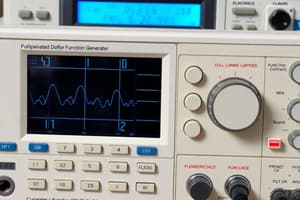Podcast
Questions and Answers
What does 'rise time' measure in an electronic signal?
What does 'rise time' measure in an electronic signal?
- The number of cycles per second of a waveform
- The time duration of a pulse in a waveform
- The time it takes for a waveform to rise from 10% to 90% of its amplitude (correct)
- The peak value of a waveform
What is the primary focus of logic analyzers?
What is the primary focus of logic analyzers?
- Analog signal analysis
- Amplitude measurement
- Frequency measurement
- Digital signal analysis (correct)
In which field are oscilloscopes used to analyze the frequency response of a system?
In which field are oscilloscopes used to analyze the frequency response of a system?
- Signal Analysis (correct)
- Testing and Quality Control
- Circuit Design
- Electronic measurement
What parameter does the 'duty cycle' of a signal waveform represent?
What parameter does the 'duty cycle' of a signal waveform represent?
What role do logic analyzers play in electronic systems?
What role do logic analyzers play in electronic systems?
What is the main function of an oscilloscope?
What is the main function of an oscilloscope?
Which type of oscilloscope offers high resolution, accurate waveform measurements, and advanced analysis features?
Which type of oscilloscope offers high resolution, accurate waveform measurements, and advanced analysis features?
What is the unique feature of an Analog Oscilloscope?
What is the unique feature of an Analog Oscilloscope?
In which fields are oscilloscopes widely used?
In which fields are oscilloscopes widely used?
What can Real-Time Oscilloscopes do that makes them suitable for high-speed signal analysis?
What can Real-Time Oscilloscopes do that makes them suitable for high-speed signal analysis?
Study Notes
Electronic Measurement: Oscilloscopes and their Significance
Introduction
Electronic measurement is an essential part of engineering and scientific exploration, enabling us to understand and analyze electronic systems and circuits. One of the most powerful tools for measuring electronic signals is the oscilloscope.
Oscilloscopes
An oscilloscope is an electronic instrument that displays the waveform of a changing voltage or current. It is widely used in the fields of electrical engineering, electronics, and telecommunications to measure and analyze the voltage or current over time. Oscilloscopes are versatile instruments that can be used for various applications, such as identifying defects in electronic circuits, measuring the frequency response of a system, and monitoring the performance of a device under test.
Types of Oscilloscopes
There are several types of oscilloscopes available, each with its own unique features and capabilities. Some of the most common types include:
-
Digital Storage Oscilloscopes (DSOs): These oscilloscopes store waveforms digitally and offer high resolution, accurate waveform measurements, and advanced analysis features.
-
Analog Oscilloscopes: These traditional oscilloscopes display waveforms using a CRT (Cathode Ray Tube) screen and offer real-time waveform display.
-
Real-Time Oscilloscopes: These oscilloscopes can capture and display waveforms in real-time, making them suitable for high-speed signal analysis.
-
Logic Analyzers: These specialized oscilloscopes focus on digital signals and can display multiple signals simultaneously.
Oscilloscope Measurements
Oscilloscopes can measure various parameters of electronic signals, such as:
- Amplitude: The peak value of a waveform.
- Frequency: The number of cycles per second of a waveform.
- Rise Time: The time it takes for a waveform to rise from 10% to 90% of its amplitude.
- Fall Time: The time it takes for a waveform to fall from 90% to 10% of its amplitude.
- Duty Cycle: The ratio of the time a signal is high to the total time it is either high or low.
- Pulse Width: The time duration of a pulse in a waveform.
Oscilloscope Applications
Oscilloscopes have numerous applications in various fields, such as:
- Circuit Design: Oscilloscopes help in the design and troubleshooting of electronic circuits by providing real-time visualization of signal waveforms.
- Signal Analysis: They can be used to analyze the frequency response of a system, identify defects in electronic circuits, and monitor the performance of a device under test.
- Testing and Quality Control: Oscilloscopes play a crucial role in the testing and quality control of electronic systems and components.
Conclusion
Electronic measurement is a critical aspect of engineering and scientific exploration, and oscilloscopes are one of the most powerful tools for measuring and analyzing electronic signals. With their ability to measure various parameters and their wide range of applications, oscilloscopes are essential for understanding and optimizing electronic systems and circuits.
Studying That Suits You
Use AI to generate personalized quizzes and flashcards to suit your learning preferences.
Description
Explore the significance of oscilloscopes in electronic measurement and their wide range of applications in electrical engineering, electronics, and telecommunications. Learn about the types of oscilloscopes, their measurements, and various applications in circuit design, signal analysis, and testing.




